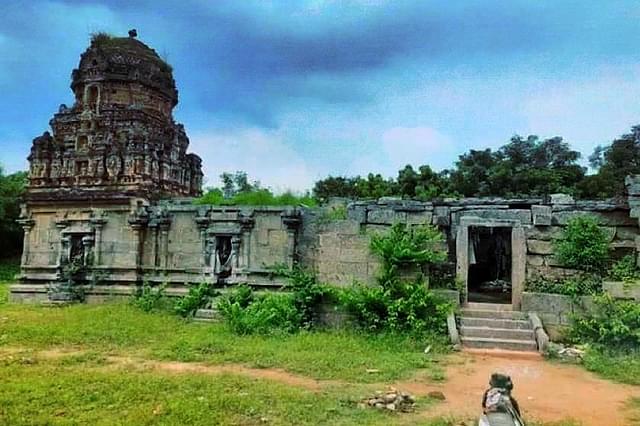Heritage
A 1,500-Year-Old Temple In Tamil Nadu That Should Have Been Renovated And Reinstated Is, Instead, Having To Fight For Its Land And Legacy
Harsha Bhat
Nov 03, 2020, 03:12 PM | Updated 03:25 PM IST
Save & read from anywhere!
Bookmark stories for easy access on any device or the Swarajya app.

The battle for justice for Hindu temples in Tamil Nadu seems to be one that has only newer names and locations propped up each time while the sad saga of neglect, destruction and injustice remain constant.
Shiva stands a mute spectator in Tamil Nadu as those who are ‘entrusted with the running of his temples’ are wreaking havoc on them one move at a time — be it letting idols be stolen and smuggled to letting its land be usurped.
This time, it is the Sri Nareeswarar temple in the newly-formed district of Kallakurichi that is paying a price for the absolute control over temples that rests in the hands of the governing authority, namely the HR&CE department.
This is a temple whose precious bronzes that were stolen over a period of time were traced two years ago by the India Pride project to museums in the west, matched them with the archives of the French Institute in Pondicherry and details of the present location provided to the government.
Yet after two years, while no effort has been made to get the idols back to the temple that they belong to, the state government 10 days ago laid the foundation for a building to house the Collectorate on a land that belongs to the same temple in Veeracholapuram, much to the angst and anger of the locals, devotees and temple activists.
On 23 October, Chief Minister Edappadi K Palaniswami laid the foundation stone for the construction of a new Collectorate in Kallakurichi which will cost the state exchequer Rs 104 crore and house more than 40 departments in a building spread over 2.7 lakh square feet.
And all these grand plans are being made when the temple whose land on which the government intends to build this lofty structure has been in a dilapidated state for decades now.
Not just the structure, but its treasures in the form of the panchaloha idols that the temple held were at the mercy of nature and as a result stolen five decades ago, as was revealed in 2018.
Activists allege that the foundation stone had been laid before the HRCE could hand over the land to the government.
Also the land’s cost has been estimated at a meagre Rs 1.98 crore, while the actual cost is estimated to be about Rs 90 crore.
Ever since the Dravidian parties — Dravida Munnetra Kazhagam (DMK) and AIADMK — came to power, temples have been targeted, allege devotees.
A controversial government ordered issued last year on 30 August, sought to ‘regularise’ non-objectionable temple land encroached by squatters for over five years.
The Madras High Court had thankfully stayed the order while taking the government to task for sending an inappropriate message to squatters on temple lands.
It had also sought that the government order a survey and furnish details of those lands that are currently missing from documents and records.
It gave the state government six months' time to retrieve these lands, but the government reverted saying it had managed to recover a mere 3,000 square feet of land and around 1,000 grounds.
Although as per reports, temples in Tamil Nadu own close to six lakh acres and three lakh square feet of property, they are yet left with only the portion that is within their walls today.
The public hearing with regard to sale of this land in Vilupuram was due on 29 October, but the foundation stone laying a week prior to it irked temple activists who took legal recourse to stall the same.
After the public hearing, it has emerged that the HRCE has erred on more grounds than one in its efforts to allow alienating 14.09 hectares of this dryland belonging to the temple.
First, say activists, the hearing should have taken place before the sale of the land, as required by Section 34 of the HR&CE Act of the State.
This section specifies that the commissioner is required to publish the intention of selling, leasing or transferring the land and seek people's opinion.
And only after it has heard the people’s views can it be sanctioned for more than five years.
On the other hand, Temple Worshippers Society president T R Ramesh, in his submission, highlighted the fact that there has been no meeting of the board of trustees, as is required by Section 34 of the HR&CE Act, for almost a decade now and neither can the ‘fit person’ nominated in the absence of the board of trustees decide the sale or lease of the land on his own.
From highlighting the fertility of the land to availability of alternate ‘waste‘ land for the building to prop up, to seeking compensation in terms of land of equal value, activists have been fighting for justice for the temple and the work on the land for the construction of the collectorate has been halted.
And this comes just months after the Madras High Court halted the government’s decision to sell off 4.7 acres of land belonging to the ancient Kadamaneshwarar temple to the Kulithalai Municipality in Karur to construct a new bus stand.
But when it comes to usurping temple lands in Tamil Nadu, unfortunately history repeats, and a tad too often with absolute disregard to the temples that were the gifts of erstwhile royalty to the region.
The temple in question too is said to have been built by Rajendra Chola, son of Raja Raja Chola, but has seen no consecration in the last 250 years and stands as a relic in ruins, despite owning vast stretches of land that were to serve as the source of income for its upkeep.
Save & read from anywhere!
Bookmark stories for easy access on any device or the Swarajya app.
Introducing ElectionsHQ + 50 Ground Reports Project
The 2024 elections might seem easy to guess, but there are some important questions that shouldn't be missed.
Do freebies still sway voters? Do people prioritise infrastructure when voting? How will Punjab vote?
The answers to these questions provide great insights into where we, as a country, are headed in the years to come.
Swarajya is starting a project with an aim to do 50 solid ground stories and a smart commentary service on WhatsApp, a one-of-a-kind. We'd love your support during this election season.
Click below to contribute.





